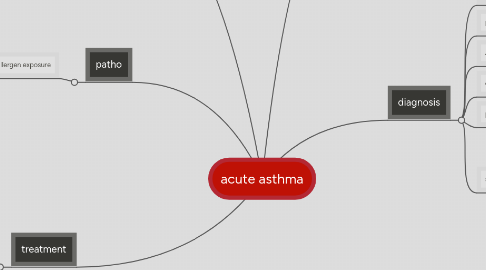
1. reduce risk of relapse
1.1. adherence to medication
1.2. food/ environmental allergens
1.3. removal of environmental factors
1.4. avoidance of triggers
1.5. compliance with medication and therapy
2. treatment
2.1. assess severity
2.1.1. correct hypoxemia
2.1.2. reverse airflow obstruction
2.1.2.1. anticholinergic meds
2.1.2.2. beta 2 agonists
2.1.2.3. systemic corticosteroids
2.1.2.3.1. within 1 hour of admission
2.1.3. reduce risk of relapse
2.1.3.1. written plan of action
2.1.3.2. regocogition of early s/s
2.1.3.3. removal of environmental factors
2.1.3.4. reduce trigger exposure
2.1.3.5. compliance with medication regimen
3. patho
3.1. allergen exposure
3.1.1. T-cell activation
3.1.1.1. eosinophil production
3.1.1.1.1. oxidative stress
3.1.2. inflammatory response activation
3.1.2.1. vasospasm
3.1.2.1.1. mucus formation, plug
4. clinical presentation
4.1. agitation
4.1.1. Goal 1
4.1.2. Goal 2
4.2. increase heart rate
4.2.1. Session Rule 1
4.2.2. Session Rule 2
4.3. increase respiratory rate
4.4. reduce lung function
4.4.1. FEV1
4.4.2. peak expiratory flow
4.5. use of accessory muscles
4.6. inability to speak
4.7. shortness of breath
4.8. wheezing
5. diagnosis
5.1. FEV1
5.2. peak expiratory rate
5.3. ABG values
5.4. oxygen saturation
5.5. physical exam
5.6. severity assessment
5.6.1. mild
5.6.1.1. may be managed at home
5.6.2. moderate
5.6.2.1. may require ED visit
5.6.3. severe
5.6.3.1. if unresponsive to treatment within 4-6 hours
5.6.3.1.1. admission into hospital
